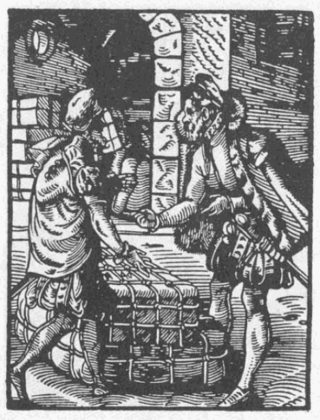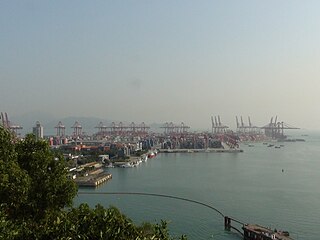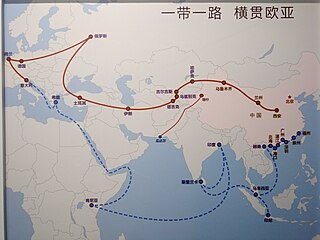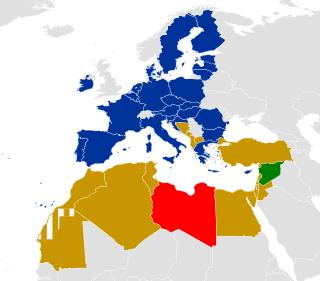
Europe is a continent comprising the westernmost peninsulas of Eurasia, located entirely in the Northern Hemisphere and mostly in the Eastern Hemisphere. It shares the continental landmass of Afro-Eurasia with both Africa and Asia. It is bordered by the Arctic Ocean to the north, the Atlantic Ocean to the west, the Mediterranean Sea to the south, and Asia to the east. Europe is commonly considered to be separated from Asia by the watershed of the Ural Mountains, the Ural River, the Caspian Sea, the Greater Caucasus, the Black Sea and the waterways of the Turkish straits.

The European Union (EU) is a supranational political and economic union of 27 member states that are located primarily in Europe. The union has a total area of 4,233,255 km2 (1,634,469 sq mi) and an estimated total population of over 448 million. The EU has often been described as a sui generis political entity combining the characteristics of both a federation and a confederation.

The economy of Italy is a highly developed social market economy. It is the third-largest national economy in the European Union, the second-largest manufacturing industry in Europe, the 8th-largest economy in the world by nominal GDP, and the 12th-largest by GDP (PPP). Italy is a founding member of the European Union, the Eurozone, the OECD, the G7 and the G20; it is the eighth-largest exporter in the world, with $611 billion exported in 2021. Its closest trade ties are with the other countries of the European Union, with whom it conducts about 59% of its total trade. The largest trading partners, in order of market share in exports, are Germany (12.5%), France (10.3%), the United States (9%), Spain (5.2%), the United Kingdom (5.2%) and Switzerland (4.6%).

The Iberian Peninsula, also known as Iberia, is a peninsula in Southwestern Europe, defining the westernmost edge of Eurasia. It is divided between Peninsular Spain and Continental Portugal, comprising most of the region, as well as Andorra, Gibraltar and a small part of Southern France. With an area of approximately 583,254 square kilometres (225,196 sq mi), and a population of roughly 53 million, it is the second-largest European peninsula by area, after the Scandinavian Peninsula.

The Mediterranean Sea is a sea connected to the Atlantic Ocean, surrounded by the Mediterranean Basin and almost completely enclosed by land: on the north by Southern Europe and Anatolia, on the south by North Africa, and on the east by the Levant in West Asia. The Mediterranean has played a central role in the history of Western civilization. Geological evidence indicates that around 5.9 million years ago the Mediterranean was cut off from the Atlantic and was partly or completely desiccated over a period of some 600,000 years during the Messinian salinity crisis before being refilled by the Zanclean flood about 5.3 million years ago.

Trade involves the transfer of goods and services from one person or entity to another, often in exchange for money. Economists refer to a system or network that allows trade as a market.

The Silk Road was a network of Eurasian trade routes active from the second century BCE until the mid-15th century. Spanning over 6,400 kilometers, it played a central role in facilitating economic, cultural, political, and religious interactions between the East and West. The name "Silk Road", first coined in the late 19th century, has fallen into disuse among some modern historians in favor of Silk Routes, on the grounds that it more accurately describes the intricate web of land and sea routes connecting Central, East, South, Southeast, and West Asia, East Africa, and Southern Europe.

A trade route is a logistical network identified as a series of pathways and stoppages used for the commercial transport of cargo. The term can also be used to refer to trade over bodies of water. Allowing goods to reach distant markets, a single trade route contains long-distance arteries, which may further be connected to smaller networks of commercial and noncommercial transportation routes. Among notable trade routes was the Amber Road, which served as a dependable network for long-distance trade. Maritime trade along the Spice Route became prominent during the Middle Ages, when nations resorted to military means for control of this influential route. During the Middle Ages, organizations such as the Hanseatic League, aimed at protecting interests of the merchants and trade became increasingly prominent.
Regional policy is the sum of a series of policies formulated according to regional differences to coordinate regional relations and regional macro operation mechanism, which affects regional development at the macro level. It includes regional economic policy, regional social policy, regional environmental policy, regional political policy, regional cultural policy, etc.Regional policy aims to improve economic conditions in regions of relative disadvantage, either within a nation or within a supranational grouping such as the European Union. Additionally, a regional policy may try to address high levels of unemployment and lower-than-average per capita incomes. Its main tool is public investment.

The history of Eurasia is the collective history of a continental area with several distinct peripheral coastal regions: the Southwest Asia, South Asia, East Asia, Southeast Asia, and Western Europe, linked by the interior mass of the Eurasian steppe of Central Asia and Eastern Europe. Perhaps beginning with the Steppe Route trade, the early Silk Road, the Eurasian view of history seeks establishing genetic, cultural, and linguistic links between Eurasian cultures of antiquity. Much interest in this area lies with the presumed origin of the speakers of the Proto-Indo-European language and chariot warfare in Central Eurasia.

The economy of Europe comprises about 748 million people in 50 countries. The formation of the European Union (EU) and in 1999 the introduction of a unified currency, the Euro, brought participating European countries closer through the convenience of a shared currency. The European Union is a unique global organisation, an entity forming one of the largest economies in the world. The European Union also “regulates” the global market by the single market. The difference in wealth across Europe can be seen roughly in the former Cold War divide, with some countries breaching the divide. Whilst most European states have a GDP per capita higher than the world's average and are very highly developed, some European economies, despite their position over the world's average in the Human Development Index, are relatively poor. Europe has total banking assets of more than $50 trillion and its Global assets under management has more than $20 trillion.

The earliest humans were hunter gatherers who were living in small, family groupings. Even then there was considerable trade that could cover long distances. Archaeologists have found that evidence of trade in luxury items like precious metals and shells across the entirety of the continent.

The history of international trade chronicles notable events that have affected the trade between various countries.

Jeddah Islamic Port is a Saudi Arabian port, located in Jeddah on the Red Sea, at the middle of an international shipping route between the east and west via the Suez Canal. It is the second-largest and second-busiest port in the Arab world. The city of Jeddah is the second-largest city in Saudi Arabia, and is Saudi Arabia's commercial capital.

The Blue Banana, also known as the European Megalopolis or the Liverpool–Milan Axis, is a discontinuous corridor of urbanization in Western and Central Europe, with a population of around 100 million. The conceptualisation of the area as a "Blue Banana" was developed in 1989 by RECLUS, a group of French geographers managed by Roger Brunet.
Port of Guangzhou is the main seaport of Guangzhou city, Guangdong province, China. The port is operated by Guangzhou Port Group Co. Ltd which is a state owned company. The company was established on February 26, 2004 from the former Guangzhou Harbor Bureau. It was approved by the Guangzhou Municipal Government. It is currently the largest comprehensive port in South China. Its international maritime trade reaches over 300 ports in more than 80 countries and districts worldwide. The port also incorporates the former Huangpu Port.

The Port of Shenzhen is a collective name of a number of ports along parts of the coastline of Shenzhen, Guangdong Province, China. These ports as a whole forms one of the busiest and fastest growing container ports in the world.

The 21st Century Maritime Silk Road, commonly just Maritime Silk Road (MSR), is the sea route part of the Belt and Road Initiative which is a Chinese strategic initiative to increase investment and foster collaboration across the historic Silk Road.

Eurafrica refers to the originally German idea of strategic partnership between Africa and Europe. In the decades before World War II, German supporters of European integration advocated a merger of African colonies as a first step towards a federal Europe.

The Belt and Road Initiative, known within China as the One Belt One Road or OBOR/1B1R for short, is a global infrastructure development strategy adopted by the Chinese government in 2013 to invest in more than 150 countries and international organizations. It is considered a centerpiece of the Chinese leader Xi Jinping's foreign policy. The BRI forms a central component of Xi's "Major Country Diplomacy" strategy, which calls for China to assume a greater leadership role for global affairs in accordance with its rising power and status. It has been compared to the American Marshall Plan. As of August 2023, 155 countries were listed as having signed up to the BRI. The participating countries include almost 75% of the world's population and account for more than half of the world's GDP.


















